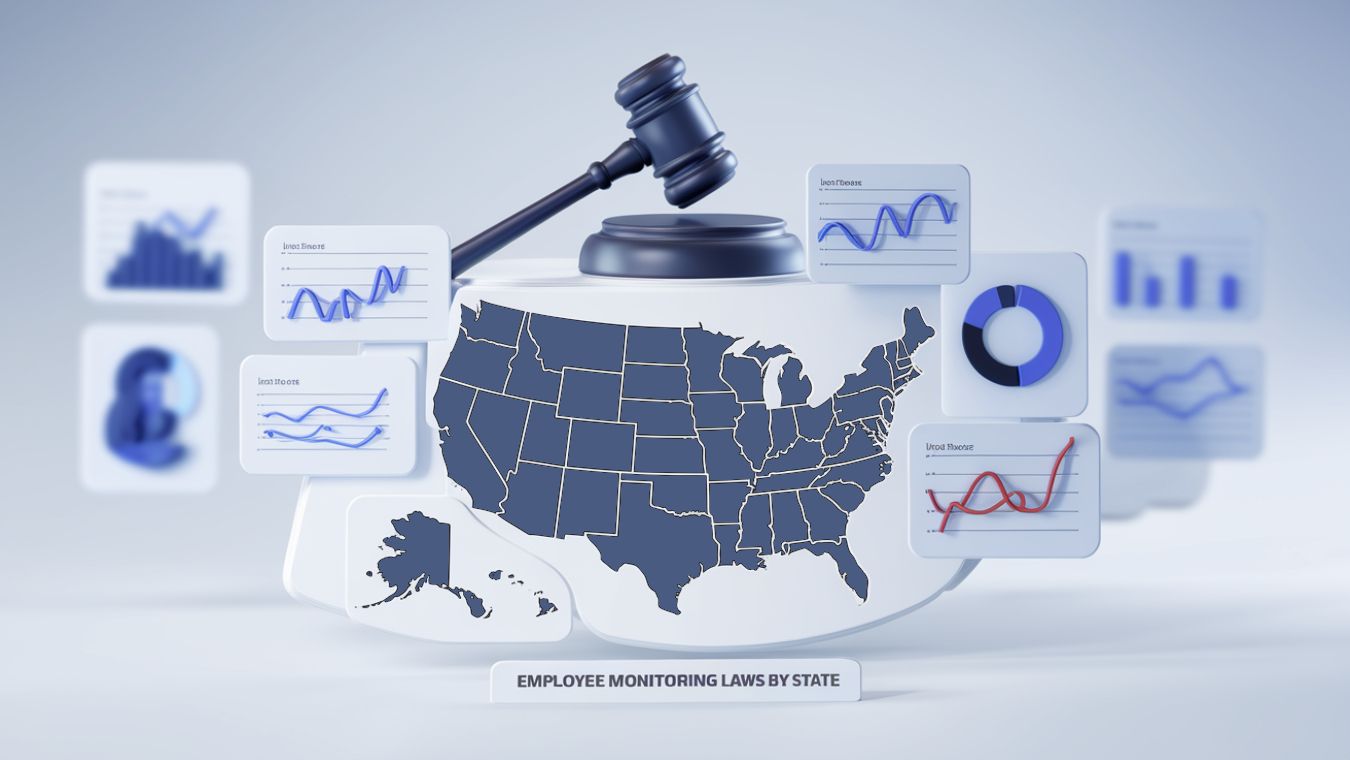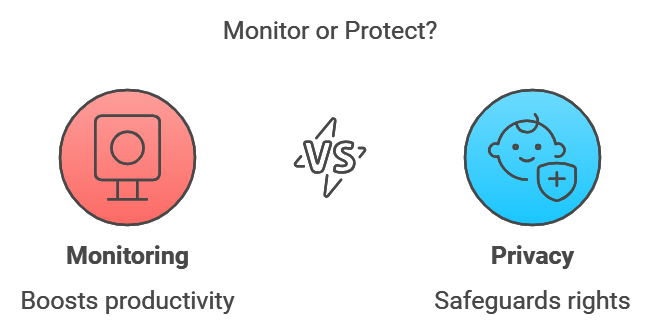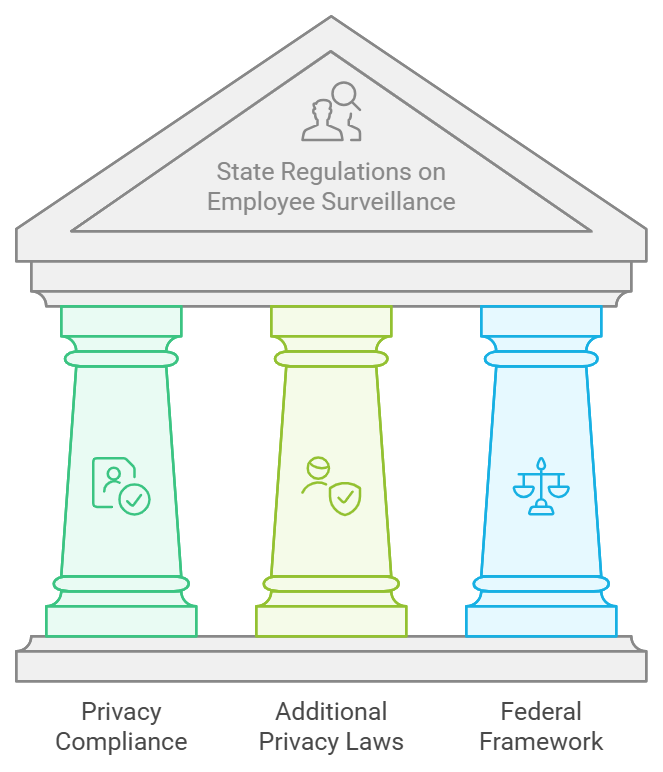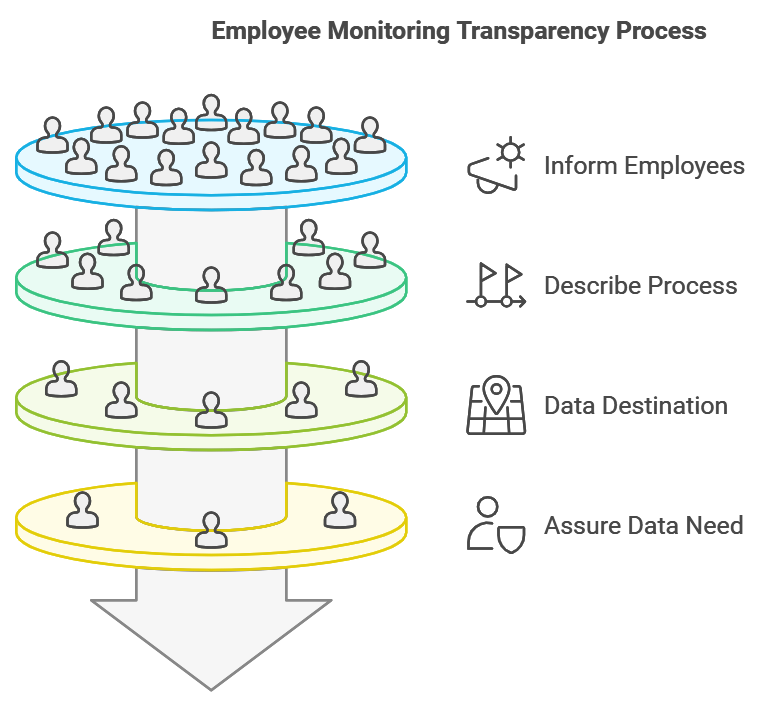Employee Monitoring Laws Explained: Federal vs. State Regulations

Say you track the computer activities that your employees know about. You have a member from Florida for whom the digital workplace policies don't matter much.
Now, you are hiring a remote worker from Delaware for your team. You want to monitor your newbie. You may be unaware that employers in Delaware need the employees' consent before monitoring.
Pretty confusing, right?
You hire both employees from the U.S., but employee privacy rights vary from state to state. It means that what is acceptable in one state may be prohibited in another.
The guide below unpacks the employee monitoring laws by state to help you understand what is legal, what isn't, and what you should know to stay protected.
Why is understanding laws on employee monitoring crucial?

Monitoring may include internet usage, computer activities, phone calls, emails, or location. Companies do it to improve productivity and security. But it raises some privacy concerns.
At this point, workplace monitoring policies are formed to protect employee rights while monitoring. But the laws all over the world vary.
For example, certain federal laws in the United States define the basis of employee data collection laws. Every state has its way of defining employee privacy and state data protection laws.
Employers need to adhere to the federal and state privacy regulations. For the workers, knowing the issue averts cases where privacy is at risk.
The legislation differences would help you perceive your obligations or rights based on where you work. Companies must make them aware of the rules to preserve corporate operational compliance and employee data.
Overview of Federal and State-Specific Employee Monitoring Laws
Federal privacy regulations for workplace monitoring policy
Federal privacy regulations in the U.S. set the basic standards for monitoring and data privacy in employment. It provides a baseline nationwide for employee rights legislation.
The 50 states of the U.S. found their employment laws and digital employee monitoring systems based on these federal foundational laws.
Electronic Communications Privacy Act (ECPA)
The ECPA is one of the major laws for workplace surveillance. It prohibits tracking calls, messages, or electronic communications without the employee's consent.
Employers can monitor employees if they obtain consent. They have to take employees' sign-on agreements or policies. Without permission, it would be considered a violation of the law to have personal emails or calls monitored.
Stored Communications Act (SCA)
The SCA is part of the ECPA limits access to stored electronic messages without permission. Employers should be cautious when intending to access a message stored in an employee's computer without their consent. Access shall only apply to information on company-owned devices. Also, employees must give clear consent through a monitoring policy.
Fair Labor Standards Act (FLSA)
FLSA requires that an individual get paid for work hours. Employers shall not monitor activities that force employees to respond after hours so as not to trigger wage claims. For overtime, employers should compensate for the extra working hours.
National Labor Relations Act (NLRA)
The NLRA protects employees' rights to discuss, join, and take collective action on workplace conditions. These rights are called "protected concerted activities." The NLRA covers most private sector employees, even if they are not in a union.
State-by-state monitoring laws

State regulations on employee surveillance change drastically from state to state. While federal laws set a general framework, individual states often adopt additional privacy compliance for companies.
Some of these are as follows:
California Employee Monitoring Law
California employers must notify employees before tracking them. For example, employers must explain how this data will be used and stored.
California's Labor Code protects the employee's life outside the workplace. Employers are bound not to monitor personal devices and activities outside the workplace.
Connecticut Employee Monitoring Policy
In Connecticut, employers need to give written notice directly to employees about the types of monitoring that may occur or post a clear notice in a visible place.
It balances the interests of monitoring employees in the workplace while being allowed to respect their privacy, except in those instances where a valid and legal cause for such monitoring exists.
New York workplace surveillance laws
New York demands written notice from employers regarding employee monitoring, especially in electronic communication such as emails, calls, or internet use. This is a 2022 law that compels employers to ensure that employees have prior knowledge of monitoring from hiring. At this point, the employer should obtain employee consent for monitoring.
Also, it implies employee monitoring software restrictions where they expect their privacy to be ensured, such as restrooms and locker rooms. The privacy laws provide that monitoring cannot occur in all personal or sensitive areas.
Texas employee monitoring and workplace privacy law
Texas allows electronic monitoring of employees in the workplace without having to notify their employees. However, Texas law emphasizes that monitoring should never violate data protection regulations.
No fixed law provides employer notice or employee consent before general monitoring. It follows general workplace monitoring legislation.
Delaware digital monitoring policies
Delaware provides a strong legal framework for monitoring employees. The employees should be told upon hiring the kind of monitoring they will be subjected to, and written notice should be given to them.
By doing so, employees are aware of how their electronic communications may be monitored while protecting their rights to privacy. Employers, in turn, can carry out necessary monitoring with clear permissions.
Illinois employee monitoring laws
Illinois does not have any specific requirements for electronic monitoring. It enforces the Biometric Information Privacy Act for using biometric data such as fingerprints, facial scans, and retinal scans. Hence, it tries to help prevent misuse of personal information. In general, it follows all the federal and corporate surveillance laws.
Florida Security of Communications Act (FSCA)
Although Florida does not have specific rules for workplace monitoring, the Florida Security of Communications Act (FSCA) operates to regulate certain types of electronic surveillance, most relevantly audio monitoring. Under the FSCA, all parties must consent to recording conversations. If a company wants to record audio, it must satisfy Florida's two-party consent law.
A quick review of employee monitoring laws by state
A comparison table of all 50 states' employees' monitoring laws would have to be simplified into basic components that vary from state to state, such as notification, consent, types of monitoring permitted, and employee protection.
| State | Notification Required | Consent Required | Employee Privacy Protections |
|---|---|---|---|
| Alabama | No | No | Limited Protections |
| Alaska | Yes | Yes (Written) | Strong privacy protections |
| Arizona | No | No | Limited Protections |
| California | Yes | Yes (explicit) | Strong privacy laws |
| Colorado | Yes | No | Limited Protections |
| Connecticut | Yes | Yes | Strong Privacy laws |
| Delaware | Yes | Yes | Notice required for electronic monitoring |
| Florida | No | No | Limited Protections |
| Georgia | No | No | Limited protections |
| Hawaii | Yes | Yes | Moderate protections |
| Illinois | Yes | Yes | Strong Protections |
| Indiana | No | No | Limited Protections |
| Iowa | Yes | No | Limited Protections |
| Kansas | No | No | Limited Protections |
| Kentucky | No | No | Limited Protections |
| Louisiana | Yes | Yes | Moderate protections for video monitoring |
| Maine | Yes | Yes | Strong protections; biometric limits |
| Maryland | Yes | Yes | Moderate protections |
| Massachusetts | Yes | Yes | Strong Protections |
| Michigan | Yes | Yes | Strong Protections Phone calls |
| Minnesota | Yes | Yes | Moderate Protections |
| Mississippi | No | No | Limited Protections |
| Missouri | No | No | Limited Protections |
| Montana | Yes | Yes | Moderate Protections |
| Nebraska | No | No | Limited Protections |
| Nevada | Yes | Yes | Strong Protections |
| New Hampshire | Yes | Yes | Strong Protections |
| New Jersey | Yes | Yes | Moderate Protections |
| New Mexico | Yes | No | Limited Protections |
| New York | Yes | Yes | Strong protections; remote work-specific laws |
| North Carolina | No | No | Limited Protections |
| North Dakota | Yes | Yes | Moderate protections |
| Ohio | No | No | Limited Protections |
| Oklahoma | No | No | Limited Protections |
| Oregon | Yes | Yes | Strong Protections |
| Pennsylvania | Yes | Yes | Strong Protections |
| Rhode Island | Yes | Yes | Strong Protections |
| South Carolina | No | No | Limited Protections |
| South Dakota | No | No | Limited Protections |
| Tennessee | No | No | Limited Protections |
| Texas | Yes | No | Limited Protections |
| Utah | No | No | Limited Protections |
| Vermont | Yes | Yes | Strong Protections |
| Virginia | Yes | Yes | Moderate |
| Washington | Yes | Yes | Strong Protections |
| West Virginia | No | No | Limited Protections |
| Wisconsin | Yes | No | Limited Protections |
| Wyoming | No | No | Limited protections |
Workplace monitoring examples

Monitoring employees has three key reasons: ensuring productivity, protecting company assets, and maintaining security. However, employers are considering legal boundaries and employee privacy rights.
There is an overview of common methods of ethical employee monitoring at the workplace.
Monitoring employees' email and internet use at work
Most employers monitor the company email accounts for security purposes to avoid data leakage and use work time correctly.
Businesses have been known to monitor employees' internet activities to ensure minimum time waste and improved productivity. Monitoring tools display websites visited by employees and time spent on inappropriate usage.
Computer and software activity tracking
Employee monitoring software tracks computer activities, including the number of keystrokes, applications utilized, and time spent. Many businesses today harness these methods to record worker productivity.
Phone call monitoring
Monitoring telephone calls is a common feature in certain aspects of customer service, such as in positions where quality control forms a significant component of the employer's interest. Employers may record calls for training or compliance reasons.
Video surveillance
Video cameras are widely used to monitor entry points, work areas, and other spaces to help maintain security and reduce theft.
Location and GPS Tracking
For field employees, such as delivery personnel, GPS tracking would entail route tracking to confirm that the best delivery times were met and verify employee safety.
Biometric Data Collection
Biometrics include fingerprint scans and facial recognition, which are becoming more common to allow secure access to buildings, time clocks, and other company systems.
Social Media and Off-Duty Activity Monitoring
Some employers observe the social media behavior of employees to assess if it reflects on the company's reputation. However, that is sensitive and can be easily invasive.
Monitoring Remote Employees
While companies permit flexible work arrangements, remote employee monitoring has become quite common. Employers normally implement remote employee monitoring to check productivity metrics, data is kept secure, and employers can remain connected with their employees.
Legal and ethical issues of employee monitoring
User activity monitoring raises many legal and ethical issues that cause many challenges. Some of them have long-term effects on employee productivity. So, it's important to identify those issues to minimize their impact.
Legal Issues of Employee Monitoring
Privacy Expectations
Workers have a right to privacy in personal spaces or when individual devices are used. Monitoring shall remain confined to the workplace. Employers should legally refrain from monitoring private areas such as restrooms or break rooms, as it is highly invasive and can encourage lawsuits.
Consent Issues
States such as New York, Delaware, and Connecticut require an employee to be notified when monitoring occurs, while California and Florida require that all parties consent to audio monitoring. The ECPA categorizes electronic communication monitoring without consent as criminal activity, particularly on personal devices. BIPA in Illinois has placed strict regulations on using biometric information like fingerprints. Consequences in cases of non-compliance are grave.
Data Security
Laws like the CCPA in California require data to be kept securely and expand employee rights over personal data. Some rules allow employees to access, inspect, or remove their records. Employers must process such applications with a specific degree of diligence.

Overtime tracking
If monitoring tempts workers into working during their off time, more so for the hourly workers, overtime pay has to be paid. This could lead to wage-related allegations if it is not adhered to.
Workplace ethics and privacy
Invasion of Privacy
Sometimes, monitoring every keystroke, browsing history tracking, video surveillance, etc., is considered overkill. Employee monitoring should not go beyond what it serves. The Ethics of surveillance of personal devices or off-duty behavior are questionable.
Transparency and Trust
Employers must be transparent regarding their monitoring policies, including what is being monitored, for what reason, and how such information will be used. Transparency engenders trust. Even though it is legal, secret monitoring hurts morale and productivity.
Employee Well-being
Continual monitoring may raise levels of stress and will hurt one's psychological well-being. These can result in a toxic workplace environment. Also, too much control over your employees can stifle creativity. Employees should be trusted to perform their functions.
Fairness and Equity
Monitoring should not be more radical against one employee than against another. It should be fair and equal for everyone. Monitoring should extend to the level necessary to track only business-related reasons, such as productivity and security. No tracking of personal data that does not relate to work, such as tracking location during one's free time.
Data Usage and Consent
Employees must be informed about the data that will be collected, the purpose for which that information shall be used, who shall have access to it, and how it will be stored. Data should not be released without consent.
How can managers help ensure that employees will accept monitoring of their time and activities?
Explain the purpose and benefits
Tell your employees that purpose monitoring is being carried out. Let them understand that monitoring is not just for tracking time, but it is helpful for everyone to work more effectively.
Be Transparent

The employees should be informed about what information is tracked. Describe in detail the monitoring process and where this tracked data goes. Assure them that only the needed data is gathered, excluding personal activities.
Take Employee Feedback
Keep the worker in the planning process and ask them for their opinion. Improve the system with this feedback so that it suits them best.
Establish Rules
Define what constitutes monitoring and at what times. It may only extend to work hours and work-related activities. Make sure it is noted that any monitoring activity does not extend to breaks, personal messages, or anything outside of work tasks.
Use Ethical and Fair Policies
Ensure that any monitoring practices are reasonable and do not involve excessive or intrusive monitoring. Collect only the data that pertains directly to the performance of the work. Do not track things irrelevant to the job.
Provide Useful Feedback
Use information obtained from monitoring to provide feedback that the employees can use to effect changes. In this way, monitoring becomes supportive of growth and well-being.
Respect Privacy
Be transparent regarding who will access the information and how it will be used. Informed consent can also mean informing employees how long data is kept and that the information will not be used outside the workplace.
Building Trust
Develop a positive work culture so employees feel valued and supported. They should know that such monitoring is done to help them, not micromanage them. When employees are trusted with their work, they become more open to monitoring, feeling it is a means of improvement rather than another way to control them.
This helps employees build trust and acceptance of the monitoring culture with these simple steps and makes them perceive it as a supportive measure rather than surveillance.
Want to Increase Your Productivity?
